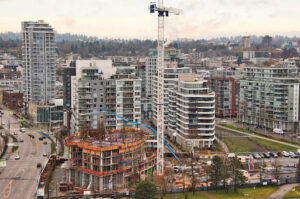Opinion | Immigration is the Solution to Canada’s Housing Crisis

Public support for immigration stood at an all-time high in 2022, following a three-decade rising trend. But last year that support crumbled to scarcely a majority. Though 51 per cent of Canadians still support immigration, 44 per cent think immigration levels are too high. And the share of Canadians who oppose immigration is growing. In 2019, Canada was the most accepting country for immigrants, according to a Gallup survey of 145 countries. Annual immigration to Canada is nearly half a million, one of the highest per-capita rates. Canada has consistently resettled more refugees than any other country. But its place as a welcoming society and multicultural bastion is slipping.
The main concern among those who say Canada is accepting too many immigrants is that housing is too expensive and scarce, and this concern is new: it rose in 2023 alongside inflation. This has been picked up by Pierre Poilievre, the leader of the Conservatives, who has accused Justin Trudeau of letting in too many immigrants, saying he “opened the floodgates in a way that was disconnected from the number of homes needed to house people.”
Blaming Canada’s rising cost of housing on immigration is an intuitive but misguided explanation. The naive logic goes like this: new immigrants increase housing demand, and housing supply can’t keep up. Yes, this is how it works in the short term. But the pressure immigrants add to housing demand pales in comparison to the broader housing crisis. And immigrants are the solution to, not the cause of, that problem.
First, I must dispel the notion that immigration is economically harmful in general. Immigrants boost the labour supply in a country, filling critical gaps and reducing costs for consumers. They also add demand by purchasing goods and services, meaning that to the extent that immigrants “take” jobs, they create them as well. Immigrants usually face different opportunity costs than the native population. This means that low-skilled immigrants often do the jobs that Canadians otherwise would not do or would require higher payment to do. This may seem exploitative, but it’s ideal compared to a world with no immigration, in which such jobs go undone (or are done at a higher cost) and immigrants who would prefer to come to Canada to do them (than to stay in their home country) are denied that opportunity.
Immigrants are more likely to start new businesses than natives. Immigrants contribute more in taxes than they receive from the government in social protection, healthcare, and education in every OECD country. Studies have shown an inverse correlation between immigration and crime in Canada, and in the United States, immigrants are less likely to commit crimes than native-born Americans. Immigration is simply terrific.

Second, the Canadian housing crisis (i.e. the undersupply of housing) is due to profound zoning and labour market problems — not immigration. According to the Canadian Mortgage and Housing Corp., Canada will need to build three and a half million more housing units than we are on track to build by 2030 to restore housing affordability. This means we need to find a huge amount of capital and massively increase our capacity to build housing.
At least a trillion dollars will be needed to finance these three and a half million housing units by 2030. Housing is usually financed with a mix of debt equity and investor equity. Debt equity will be easier to raise because it’s low-risk: you lend out money and get paid back. Investor equity, which gives investors an ownership stake in the housing they invested in, will be harder to raise. This kind of capital doesn’t appear out of nowhere: it’s not sitting in Canadians’ bank accounts waiting to be directed at housing. A massive influx of foreign investment will be needed to finance the construction of all this new housing. Though foreign investment is often associated with speculation and vacancy, these issues can be addressed with targeted regulation.
We also must abolish housing zoning regulations that restrict density and preserve the hegemony of single-family homes in most Canadian cities. In Toronto, 60 per cent of residential land is reserved for single family homes. In Vancouver, it’s 80 per cent. Montreal (46 per cent) is doing quite better than its peers. Such zoning regulations curb housing supply by preventing developers from building duplexes, rowhouses, apartment buildings, and the like. Reducing zoning regulations would also benefit current land owners in cities, who are often the opponents of such efforts, and for whom the term “NIMBY” (not in my backyard) was invented. It would allow landowners to build more units on their property. Just having this option should increase the value of their land, and actually doing it would allow landowners to take in more rent. Reducing zoning regulations increases land value while decreasing housing costs. (To really fix the housing crisis and tackle wealth inequality, we should create a land value tax, but that’s the topic for another article.)

To address our capacity issues, we must fix the undersupplied construction sector. Immigrants can and must be a part of the solution by helping address this labour shortage. The construction industry is expected to have 300,000 vacancies eight years from now due to an aging labour force. Construction is costly and slow—the average construction project in Canada takes 18 months to be completed. The issue is that Canadians generally don’t want to work in construction. Construction labourers make more than many new graduates with bachelor degrees, but we don’t see Canadians opting en masse to work in construction over going to university. The good news is that there are tons of people across the world who would love to come to Canada, who would be happy to work in construction, and who often have previous experience in the sector.
The current Canadian immigration system heavily favours immigrants with university diplomas or two-year apprenticeships, those who are least inclined to work in construction. One of the only ways immigrants without such education can come to Canada is through the Federal Skilled Trades Program (FSTP), and FSTP immigrants make up less than one per cent of total economic immigrants. Low-skilled construction labourers can’t even apply through FSTP. In construction, only workers with specific skills (like industrial mechanics, millwrights, and supervisors) are admissible through FSTP. Only two per cent of total immigrants go into construction, and this percentage is falling, according to CIBC. The system is horribly ill-matched to the needs of the Canadian economy.
Finally, there is a moral argument to be made for immigration. People who leave their homeland in search of opportunity don’t do so lightly: they leave behind friends, family, and community. They leave due to push factors like poverty, violence, and political repression. While recently visiting my grandmother in Mexico, I went to a migrant shelter in Celaya, Guanajuato State. There I met people my age from Central and South America who were making the arduous journey north. They face the risk of deportation and exploitation, given their precarious legal status. And their journey is treacherous: many were severely injured or handicapped. We played ping pong, ate lunch together, and chatted. Their resilience in the face of danger and an uncertain future was remarkable. They seem overwhelmingly deserving of a chance to make a new life here, and they represent the most daring, determined people I’ve ever met. Scapegoating them for rising housing costs is incorrect and malicious. Such rhetoric, which often carries nativist undertones, harms some of the world’s most vulnerable people while diverting public attention from the root causes of the housing crisis. It helps no one.
Canada must encourage foreign capital inflows to finance new housing. We must dismantle the zoning rules that allow NIMBYs to keep housing prices ridiculously high in their neighbourhoods. And we must open our arms to immigrants, especially low-skilled ones who are likely the most underprivileged and who would be the most beneficial to Canada. Let’s reclaim our status as a welcoming, multicultural society.
Edited by Selin Abali
Featured Image: Canada has a moral obligation to take in immigrants—luckily, immigration benefits Canada too. Migrants by Gémes Sándor is licensed under CC BY-SA 3.0 DEED.
